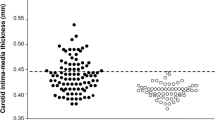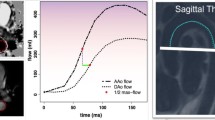Abstract
Vascular and endothelial functions were investigated in long term survivors of childhood cancer exposed to anthracycline treatment. We enrolled 96 long-term survivors (57 males and 39 females, mean age 14.9 ± 5.3 year) of different childhood cancers and 72 age-, sex-, bodyweight- and blood pressure matched controls (39 males and 33 females, mean age 13.7 ± 4.9 year). Aortic stiffness was characterized by echocardiography. Brachial artery endothelial function was assessed by flow-mediated dilatation (FMD%) and nitrate-mediated dilatation (NTG%). Results were compared between three subgroups: anthracycline treated, only chemotherapy treated and control subgroups. The cumulative anthracycline dose was less than 350 mg/m2. The healthy control subgroup had a significantly greater FMD response (13.13 ± 2.40 %), and lower stiffness index (2.08 ± 0.6) than both the anthracycline (7.12 ± 6.28 % and 6.45 ± 3.25, respectively) and only chemotherapy treated (10.17 ± 4.23 % and 4.12 ± 2.32, respectively) subgroups. In the anthracycline treated subgroup a significantly (p < 0.01) lower FMD% response, and higher stiffness index were detected than in the only chemotherapy treated subgroup. Higher triglyceride level, higher cumulative anthracycline dose and lower age at the start of treatment were found to be associated independently with impairment of FMD% response and aortic stiffness. We found a significant negative correlation between FMD and aortic stiffness (p < 0.001) and a positive correlation between FMD and distensibility (p < 0.0001) Childhood cancer long term survivors exposed to anthracycline treatment exhibit a marked preclinical vasculopathy, characterized by endothelial dysfunction and increased arterial stiffness, contributing to a deteriorated cardiovascular function.


Similar content being viewed by others
References
Yeh ET, Tong AT, Lenihan DJ et al (2004) Cardiovascular complications of cancer therapy. Diagnosis, pathogenesis, and management. Circulation 109:3122–3131
Shankar SM, Marina N, Hudson MM et al (2008) Cardiovascular Disease Task Force of the Children’s Oncology Group. Monitoring for cardiovascular disease in survivors of childhood cancer: report from the Cardiovascular Disease Task Force of the Children’s Oncology Group. Pediatrics 121:387–396
Hochster H, Wasserheit C, Speyer J (1995) Cardiotoxicity and cardioprotection during chemotherapy. Curr Opin Oncol 7:304–309
Bristow MR, Thompson PD, Martin RP, et al. Early anthracycline cardiotoxicity. Am J
Dengel DR, Ness KK, Glasser SP et al (2008) Endothelial function in young adult survivors of childhood acute lymphoblastic leukemia. J Pediatr Hematol Oncol 30:20–25
Oeffinger KC, Buchanan GR, Eshelman DA et al (2001) Cardiovascular risk factors in young adult survivors of childhood acute lymphoblastic leukemia. J Pediatr Hematol Oncol 23:424–430
Widlansky ME, Gokce N, Keaney JF Jr et al (2003) The clinical implications of endothelial dysfunction. J Am Coll Cardiol 42:1149–1160
Arnett DK, Evans GW, Riley WA (1994) Arterial stiffness: a new cardiovascular risk factor? Am J Epidemiol 140:669–682
Murata T, Yamawaki H, Yoshimoto R et al (2001) Chronic effect of doxorubicin on vascular endothelium assess by organ culture study. Life Sci 69:2685–2695
Wu S, Ko Y, Teng M et al (2002) Adriamycin-induced cardiomyocyte and endothelial cell apoptosis: in vitro and in vivo studies. J Mol Cell Cardiol 34:1595–1607
Amy YC, Clifford C, Gary D et al (2006) Anthracyclines cause endothelial injury in pediatric cancer patients: a pilot study. J Clin Oncol 24:925–928
Bárdi E, Oláh AV, Bartyik K et al (2004) Late effects on renal glomerular and tubular function in childhood cancer survivors. Pediatr Blood Cancer 43(6):668–673
Schrappe M, Reiter A, Zimmermann M et al (2000) Long-term results of four consecutive trials in childhood ALL performed by the ALL-BFM study group from 1981 to 1995, Berlin-Frankfurt-Munster. Leukemia 14:2205–2222
Creutzig U, Ritter J, Zimmermann M et al (2001) Improved treatment results in high-risk pediatric acute myeloid leukemia patients after intensification with high-dose cytarabine and mitoxanthrone: results of Study Acute Myeloid Leukemia-Berlin-Frankfurt-Munster 93. J Clin Oncol 19:2705–2713
Reiter A, Schrappe M, Parwaresch R et al (1995) Non-Hodgkin’s lymphomas of childhood and adolescence: results of a treatment stratified for biologic subtypes and stage – a report of the Berlin-Frankfurt-Munster Group. J Clin Oncol 13:359–372
Schellong G, Pötter R, Brämswig J et al (1999) High cure rates and reduced long-term toxicity in pediatric Hodgkin’s disease: the German-Austrian multicenter trial DAL-HD-90. The German-Austrian Pediatric Hodgkin’s Disease Study Group. J Clin Oncol 17:3736–3744
Marx M, Langer T, Graf N et al (2002) Multicentre analysis of anthracycline-induced cardiotoxicity in children following treatment according to the nephroblastoma studies SIOP No. 9/GPOH and SIOP 93-01/GPOH. Med Pediatr Oncol 39:18–24
Ozaki T, Flege S, Kevric M et al (2003) Osteosarcoma of the pelvis: experience of the Cooperative Osteosarcoma Study Group. J Clin Oncol 21:334–341
Koscielniak E, Jürgens H, Winkler K et al (1992) Treatment of soft tissue sarcoma in childhood and adolescence. A report of the German Cooperative Soft Tissue Sarcoma Study. Cancer 70:2557–2567
Tweddle DA, Pinkerton CR, Lewis IJ et al (2001) OPEC/OJEC for stage 4 neuroblastoma in children over 1 year of age. Med Pediatr Oncol 36:239–242
Celermajer DS, Sorensen KE, Gooch VM et al (1992) Non-invasive detection of endothelial dysfunction in children and adults at risk for atherosclerosis. Lancet 340:1111–1115
Kelly AS, Kaiser DR, Dengel DR et al (2004) Comparison of B-mode and echo-tracking methods of assessing flow-mediated dilation. Ultrasound Med Biol 30:1447–14
Celik T, Iyisoy A, Acikel C et al (2008) The comparative effects of metoprolol and perindopril on aortic elasticity in young patients with prehypertension. Blood Press Monit 13:169–176
Lacombe F, Dart A, Dewar E et al (1992) Arterial elastic properties in man: a comparison of echo-Doppler indices of aortic stiffness. Eur Heart J 13:1040–1045
Fahey M, Ko HH, Srivastava S et al (2009) A comparison of echocardiographic techniques in determination of arterial elasticity in the pediatric population. Echocardiography 26:567–573
Chow AY, Chin C, Dahl G, Rosenthal DN (2006) Anthracyclines cause endothelial injury in pediatric cancer patients: a pilot study. J Clin Oncol 24:925–928
Chaosuwannakit N, D’Agostino R Jr, Hamilton CA et al (2010) Aortic stiffness increases upon receipt of anthracycline chemotherapy. J Clin Oncol 28(1):166–172
Hashimoto M, Akishita M, Eto M et al (1995) Modulation of endothelial-dependent flow-mediated dilatation of the brachial artery by sex and menstrual cycle. Circulation 92:3431–3435
Lewis TV, Dart AM, Chin-Dusting JP (1999) Endothelium-dependent relaxation by acetylcholine is impaired in hypertriglyceridemic humans with normal levels of plasma LDL cholesterol. J Am Coll Cardiol 33:805–812
Lupattelli G, Lombardini R, Schillaci G et al (2000) Flow-mediated vasoactivity and circulating adhesion molecules in hypertriglyceridemia: association with small, dense LDL cholesterol particles. Am Heart J 140:521–526
Lundman P, Eriksson MJ, Stühlinger M et al (2001) Mild to moderate hypertriglyceridemia in young men is associated with endothelial dysfunction and increased plasma concentrations of asymmetric dimethylarginine. J Am Coll Cardiol 38:111–116
Ceriello A, Taboga C, Tonutti L et al (2002) Evidence for an independent and cumulative effect of postprandial hypertriglyceridemia and hyperglycemia on endothelial dysfunction and oxidative stress generation. Circulation 106:1211–1218
Bae JH, Bassenge E, Lee HJ et al (2001) Postprandial hypertriglyceridemia impairs endothelial function by enhanced oxidant stress. Atherosclerosis 115:517–523
Marjolen W, Sebastian JN, Aart-Jan L et al (2010) The metabolic syndrome in adult survivors of childhood cancer, a Review. J Pediatr Hematol Oncol 32:171–179
de Bor H, Blok GJ, Voerman HJ et al (1994) Serum lipid levels in growth hormone-deficient men. Metab: Clin Exptl 43:199–203
Angelina B, Olivecrona H, Ericsson S et al (1993) Growth hormone and low-density lipoproteins. Acta Endocrinol 128(suppl2):26–28
Darzy KH (2009) Radiation-induced hypopituitarism after cancer therapy: who, how and when to test. Nat Clin Pract Endocrinol Metab 5(2):88–89
Kitajima M, Hirai T, Maruyama N et al (2007) Asymptomatic cystic changes in the brain of children after cranial irradiation: frequency, latency, and relationship to age. Neuroradiology 49(5):411–417
Duquaine D, Hirsch GA, Chakrabarti A et al (2003) Rapid-onset endothelial dysfunction with adriamycin: evidence for a dysfunctional nitric oxide synthase. Vasc Med 8:101–107
Acknowledgments
The help of Zsolt Karányi in performing statistical analysis is acknowledged. This work was supported by the grant of the Health Science Council of the Ministry of Education Republic of Hungary (ETT) No. 396/2006, 01-478/2009 and by the “For the leukemic children” foundations. The publication is supported by the TÁMOP 4.2.1./B-09/1/KONV-2010-0007 project. The project is co-financed by the European Union and the European Social Fund.
Conflict of Interest
None declared.
Author information
Authors and Affiliations
Corresponding author
Additional information
Zoltan Jenei and Edit Bárdi Equal opportunity first authors.
Rights and permissions
About this article
Cite this article
Jenei, Z., Bárdi, E., Magyar, M.T. et al. Anthracycline Causes Impaired Vascular Endothelial Function and Aortic Stiffness in Long Term Survivors of Childhood Cancer. Pathol. Oncol. Res. 19, 375–383 (2013). https://doi.org/10.1007/s12253-012-9589-6
Received:
Accepted:
Published:
Issue Date:
DOI: https://doi.org/10.1007/s12253-012-9589-6




